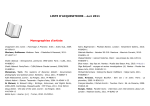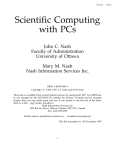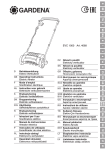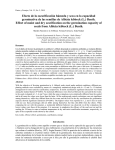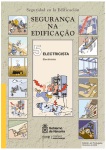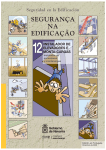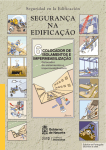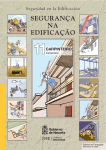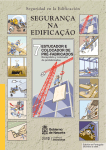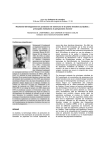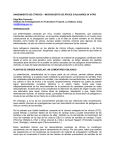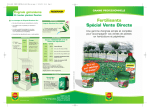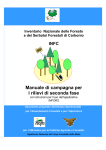Download A GUIDE TO CONTAINER TREE SEEDLING PRODUCTION
Transcript
LEBANON REFORESTATION INITIATIVE A GUIDE TO CONTAINER TREE SEEDLING PRODUCTION 2014 DISCLAIMER: This manual is made possible by the support of the American people through the United States Agency of International Development (USAID). The content of this manual is the sole responsibility of the US Forest Serviceand does not necessarily reflect the views of the United States Government. Preface This manual was written for the Lebanon Reforestation Initiative to improve nursery practices and support seedling production in Lebanon. It is meant to fill the gap between practical experience and technical manuals and highlights some of the key aspects involved in container production through a series of step-by-step guides. Because of its brevity, this publication does not attempt to thoroughly explain the theory behind many plant propagation concepts discussed here, but instead is meant to be supplemented with other existing technical nursery publications. About the Authors Anthony S. Davis is an Assistant Professor of Native Plant Regeneration and Silviculture and Director of the Center for Forest Nursery and Seedling Research; Department of Forest, Rangeland, and Fire Sciences; University of Idaho, Moscow, Idaho. Olga A. Kildisheva is a Research Scientist, Center for Forest Nursery and Seedling Research; Department of Forest, Rangeland, and Fire Sciences; University of Idaho, Moscow, Idaho. Matthew M. Aghai is a Research Scientist, Center for Forest Nursery and Seedling Research; Department of Forest, Rangeland, and Fire Sciences; University of Idaho, Moscow, Idaho. Acknowledgements Funding for this project was provided by the United States Department of Agriculture (USDA), Foreign Agricultural Service, Office of Capacity Building and Development under the participating agency service agreement with the United States Forest Service International Programs (USFS IP) and the Lebanon Reforestation Initiative (LRI). We thank the LRI team for their assistance and on-the ground support that made this project possible. We also appreciate the cooperation and receptiveness of numerous nursery managers and growers. Design and layout by: Olga A. Kildisheva Photography by (unless stated otherwise): Matthew M. Aghai, Karma Bouazza, Anthony S. Davis, and Olga A. Kildisheva All photographs used in this publication remain the property of the original copyright holder. Photographs should not be reproduced or used in other contexts without written permission from the copyright holder. Produced by: University of Idaho Center for Forest Nursery and Seedling Research, University of Idaho, P.O. Box 441137, Moscow, Idaho, 83844-1137, USA Available from: Lebanon Reforestation Initiative Olivetti Building, 8th Floor Corniche Pierre Gemayel, Mathaf, P.O. Box 16-6975 Beirut, Lebanon Table of Contents 1. Workplace Safety General Safety Working with Acids Working with Fertilizers Working with Machinery and Moving Parts 1.1 1.2 1.3 1.4 2. Keeping Records 3. Crop Development Crop Planning Seedling Growth Phases Pruning 3.1 3.2 3.3 4. Working with Seeds Seed Handling and Cleaning Seed Cleansing Seed Storage Seed Imbibition Test Seed Germination Test Determining Seed Dormancy Type Seed Stratification 4.1 4.2 4.3 4.4 4.5 4.6 4.7 5. Irrigation Setting a Gravimetric Weight Scale Assessing Irrigation Uniformity within a Watering Zone 5.1 5.2 6. Fertilization General Fertilizer Information Measuring pH and EC 6.1 6.2 7. Phytosanitation Appendix Additional Resources General Safety Keeping Records Section 1.1: General Safety The nursery environment can have a high potential for injuries if necessary precautions are not taken. Consider the safety of yourself and your employees during daily activities. The information below outlines some key aspects of maintaining safety in the workplace. Employer Responsibilities: • Identify and warn workers about potential hazards at the nursery1 Examples include: acids, fertilizers, pesticides, fungicides, machinery, etc. • Label all hazardous chemicals and store them in a designated place such as a chemical cabinet • Train your employees to use necessary precautions when handling hazardous materials and communicate about potential hazards verbally and in writing to make sure your employees understand the consequences associated with careless handling of dangerous materials General Rules for Working with Chemicals:1 • Never store or handle unmarked chemicals • Include the chemical name and potential hazards associate with its use on the container If this data is not provided on the original container it should be printed and attached to the container used to store the chemical (See next page). • Always wear protective equipment • When mixing chemicals keep them below eye-level to avoid splashing your face • • • • Protective Equipment: Goggles Respirator, mask, or scarf to cover the nose and mouth Long-sleeved shirt and pants made of washable materials Socks, shoes (not sandals), and gloves that extend past the wrist Occupational Safety and Health Administration. May 30, 2007. Landscaping and Horticulture Safety. www. osha.gov/dte/grant.../fy06/.../english_b_6_health_hazcom.ppt [Last accessed September 18, 2012]. 1 Section 1.1: General Safety Below is an example of a chemical label for sulfuric acid. An empty template is also provided below and can be cut out, photocopied, and used at your nursery. Substance: Sulfuric Acid (H2SO4) Health Risk Flammability Physical Hazard Protective Wear Details: • • • • • • • Can affect your lungs when inhaled, higher exposures can cause a build-up of fluid in lungs Is a carcinogen Corrosive contact can severely burn the skin, eyes, and may lead to blindness Can cause headache, nausea, and vomiting Can cause permanent lung damage, damage teeth, and upset stomach Can enhance the combustion of other substances, will explode in a fire Will produce poisonous gases in a fire Substance: Health Risk Flammability Physical Hazard Protective Wear Details: Substance: Health Risk Flammability Physical Hazard Protective Wear Details: Section 1.2: Working with Acids Working with Acids: When handling acids, always wear a face mask/goggles, gloves, and cover all exposed body parts.1 Store protective wear in one location that is easily accessible to all employees. When diluting acids, always pour acid into water slowly. Never pour water into acid! Why do you add acid to water and not the other way around: When acid reacts with water a large amount of heat is released. When one adds water to acid, the initial concentration of acid is very high and so much heat is released that the solution may boil violently, causing concentrated acid to splash out of the container. However, if acid is added to water the acid concentration in the mixture is low and increases gradually, releasing only a small amount of heat, thus reducing the hazard.2 Proper Procedures for Mixing Acid: Proper Acid Disposal: 1 Pour a desired amount of water into a bucket/container. 1 2 2 Put on rubber gloves, long sleeve shirt, apron, and goggles. 3 Place bucket lower than eye level (to prevent splashing acid into your face). Dilute acid by pouring it slowly into a container of water. Make sure you have at least twice as much water as acid. Do not dispose of acid indoors! 4 Slowly pour in the desired amount of acid, mixing the solution slowly. 2 Senese, F. January 1997. http://antoine.frostburg.edu/chem/senese/101/safety/faq/always-add-acid.shtml [Last accessed September 18, 2012] Section 1.2: Working with Acids General First Aid Steps for Acid Exposure:3 In case of eye contact: In case of skin contact: In case of inhalation: 1 1 1 2 2 2 3 3 3 Remove contaminated clothing as soon as possible. Wash the affected area with large amounts of water and soap. Seek medical attention as soon as possible. Flush eyes immediately with a large amount of water for at least 30 minutes. Make sure that water reaches the underside of the upper and lower lids. Contact medical help as soon as possible. Disposing of hazardous materials:1 Potentially hazardous materials include items such as: • • • • Exit the affected area immediately and seek medical attention. If the victim is unconscious they must be removed from the affected area immediately. Rescue breathing must be administered, but precautions should be taken to avoid transfer of poisonous vapors into the rescuer’s lungs. 4 Contact medical help as soon as possible. broken glass old chemical containers acid/chemical drenched towels other sharp materials To avoid problems: • Label potentially dangerous trash and trashcans containing that material • Designate a box or container for broken glass and other sharp objects New Jersey Department of Health. Right to Know Fact Sheets. http://www.nj.gov/health/eoh/rtkweb/ [Last accessed September 18, 2012]. 3 Section 1.3: Working with Fertilizers Working with Fertilizers: Proper fertilizer use can enhance plant growth and help to produce healthy seedling; however, poor use and handling of fertilizers can be harmful to nursery employees and the environment. Some fertilizers are flammable, can cause irritation, and can contaminate ground water. To avoid these problems follow the guidelines provided below: General Rules for Working with Fertilizers:1 When storing: • Always store fertilizers in a correctly labeled containers/bags, in a dry place away from sources of heat or fire • Place a fire extinguisher close to the fertilizer storage area in case of an emergency When using: • Workers should wear protective clothing when mixing fertilizers • Use a backflow preventer to ensure that water containing fertilizer or pesticide is not mixed back in with water used for human consumption • Monitor fertilizer runoff and take measures to avoid the mixing of runoff with surface water such as a stream or lake • Mix slow release fertilizer into the media directly to avoid leaching of fertilizer that is top-dressed • Remember that temperature and moisture of the growing media will influence the fertilizer release rate • Know your fertilizer conversions and injector rates • Reduce fertilizer runoff by placing species that require the same fertilization frequency into the same irrigation zones Section 1.4: Working with Machinery and Moving Parts Working with Machinery and Moving Parts: Operating machinery such as cement mixers, tractors, media mixers, and so on may be required. Care must be taken by both the employer and the employees to insure that all hazards associated with moving parts, electricity, dust and other flying debris are eliminated. Follow the following steps to minimize risks: General Rules for Working with Machinery and Moving Parts: • Take the time to train and practice with new machinery and new employees • Wear a respirator and goggles if dealing with fine materials that can be inhaled or lodged in eyes (i.e. mixing growing media and perlite) • Keep fingers out of the way of any moving parts • Before beginning to operate any machinery check your surroundings, if others are around, inform them about what you plan on doing Section 2: Keeping Records Taking notes is vital to the success of a nursery. Detailed records will help: a) assess progress of the current crop, b) plan for next year’s crop production, and c) understand which practices were beneficial and which hindered progress.1 The three components of this section will help with keeping records that lead to success: 1 The Daily Checklist is meant to be completed every day, preferably at the start of the day before beginning work. This will allow the grower to be aware of tasks that need to take place and plan daily activities accordingly. 2 The Daily Irrigation Log is designed to record the water status of each crop on a daily basis. The grower should use gravimetric weights to measure the weight of designated trays and calculate the dry down weight for each species. This will help determine whether the species should be watered (See Section 5.1). If a crop is irrigated the following information should be recorded in the Daily Irrigation Log: a. the amount/duration of application b. fertilizer rate and type 3 The Weekly Log helps summarize the activities that take place every week. It includes information regarding the tasks that were completed, the amount of people and time required. In addition, the form helps summarize nursery financial records by providing space to document customer orders as well as the purchases made by the nursery on a weekly basis. Below you will find examples of each form, in addition empty templates of the same forms can be found in the Appendix. These forms can be modified to better fit your nursery, but the general information should remain the same. Jacobs, D.F. and K.M. Wilkinson. 2009. Chapter 3: Planning crops and developing propagation protocols. In: Dumroese, R.K., Luna, T. and T.D. Landis, Editors. Nursery manual for native plants: A guide for tribal nurseries - Volume 1: Nursery management. Agriculture Handbook 730. Washington, D.C.: U.S. Department of Agriculture, Forest Service. p. 177-199. 1 Section 2: Keeping Records Name: Matthew Date: June 10, 2012 The Daily Checklist Daily Task Completed Notes Walk through the entire nursery and take a look at all of the crops; take note of any problems or tasks that needs to be done today weed the area around the Pinus pinea crop Check the Fraxinus crop for insect damage Write down the temperature (take note of the temperature variation throughout the plant production area, if multiple thermostats are available) Location: main greenhouse Time: 8:30 )morning( High (C°): 38 Low (C°): 24 Weed the area around the plants Zone 2 and 3 )towards the back of greenhouse( Check the sprinkler nozzles to make sure they are attached/clean Need to clean nozzles in the front of the greenhouse Check whether plants need extra perlite, thinning, or sorting Need to add perlite to the Cedrus libani containers Take block weights of all of the crops Early, week 2 Middle, week 5 Pinus pinea Crop phase Fraxinus angustifolia subsp. syriaca Species Name: Matthew Date: June 10, 2012 Section 2: Keeping Records 7.4/8.7 kg x 100=85% 7.3/8.5 kg x 100=85% Gravimetric weight per tray Irrigation (amount/duration) 100 ppm N of 30-10-10 Soluble fertil- Fertilized with the overhead sprinkler with izer Peters Professional for 30 minutes injector set to 1:200 6 g of Basacote ® 6M per D40 container; Watered with an overhead sprinkler for 30 mixed into media before sowing minutes Fertilization (rate, type) The Daily Irrigation Log 3 hours 3 hours Weeding Mixing Fertilizer Seedling number: 1000, D40 seedlings Species: Cedrus libani Orders: 2 people 10 hours Mixing media and filling containers LRI Purchaser: 1 person 1 person 2 people Duration: Number of people required: The Weekly Log Sowing Pinus pinea, Cedrus libani, and Fraxinus angus- 20 hours tifolia seeds Tasks: Name: Matthew Week: July 2-8, 2012 Section 2: Keeping Records 100 bricks at $... 3 for $... Bought replacement nozzles for sprinklers Amount: Bough more cocopeat Item/Service: Purchases: Running low on Cocopeat, need to purchase more Some seeds were moldy, may need to decrease moisture during storage General Notes: Section 3.1: Crop Planning Careful crop planning is critical to successful nursery management. Crop planning allows the grower to visualized the entire production process, anticipate potential needs, and allow for proper timing so that the crop can be ready for the customer on a pre-designated date. The following steps must be considered when planning for crop production:1 1 Identify the amount of space available for plant production at your nursery. 2 Create a layout for the crop based on the number of seedlings that must be produced. Take into account the available growing space, container type, germination rate, and potential mortality throughout the growing season. Greenhouse 3 Identify the seed source for each crop and schedule collection or purchase. Consider seed ripening date and the time required to collect and process the seeds. 4 Identify and schedule any treatments that are necessary prior to sowing. row Consider seed dormancy requirements, materials needed to treat seeds, and the duration of treatment needed for each species. N 5 Schedule crop establishment. Consider the plant growth phases (Refer to Section 3.2) and the requirements for each. Species Container Number Quercus calliprinos D 40 300 Fraxinus angustifolia D 40 200 Arbutus unedo D 40 300 Pinus pinea D 40 1,400 Cedrus libani D 40 1,100 6 Create a crop schedule that insures the production of a quality seedling by the target date. This can be done electronically or by using a calendar. Jacobs, D.F. and K.M. Wilkinson. 2009. Chapter 3: Planning crops and developing propagation protocols. In: Dumroese, R.K., Luna, T. and T.D. Landis, Editors. Nursery manual for native plants: A guide for tribal nurseries - Volume 1: Nursery management. Agriculture Handbook 730. Washington, D.C.: U.S. Department of Agriculture, Forest Service. p. 177-199. 1 Section 3.2: Seedling Growth Phases Growers can monitor plants through observation and regular measurements. Seedlings follow three phases of development during nursery culture: early, middle, and hardening phase. The timing of each phase will vary by species, sowing date, nursery culture, location, and weather. The following description simplifies each stage and provides a framework for keeping records to be referenced in the future:1,2 Early Phase Objective • Maximize the number of containers filled with healthy seedlings • Phase can last 4 to 8 weeks depending on a species and culturing conditions • Phase is complete with the first flush of needles or true leaves Growing Conditions Irrigation Temperature, humidity and light should be favorable for seed germination. Keep the surface of the growing media moist. Excess water can cause crop disease but too little water will prevent germination or damage newly germinated seedlings. Irrigation can be regulated using gravimetric weights (See Section 5.1) set to a percentage that allows for ample water to be available to the seedlings throughout this phase (i.e.>85%), or by setting irrigation frequency based on environmental conditions (i.e. water once a day or water twice a day if temperatures exceed 27°C). Fertilization Fertilization is unnecessary in this phase. If soluble fertilizer is applied, be sure the concentrations are low to avoid salt injury. Additional The first two weeks: Information • Monitor the crop closely so that resowing, thinning, and transplanting can occur promptly • Resow the empty cells if germination hasn’t occurred Resowing outside of the two-week window will result in uneven crop age, a delay in crop schedule, and seedlings that will not reach the target size by outplanting. • Thinning should start as soon as possible to reduce competition for resources (e.g. water, light, rooting space) among seedlings Jacobs, D.F. and K.M. Wilkinson. 2009. Chapter 3: Planning crops and developing propagation protocols. In: Dumroese, R.K., Luna, T. and T.D. Landis, Editors. Nursery manual for native plants: A guide for tribal nurseries - Volume 1: Nursery management. Agriculture Handbook 730. Washington, D.C.: U.S. Department of Agriculture, Forest Service. p. 177-199. 1 Section 3.2: Seedling Growth Phases Middle Phase Objective • Provide ample amounts of water, fertilizer, and sunlight to maximize seedling growth • Phase can last up to 3 months depending on species and environmental conditions • Phase is complete when 2/3 of target seedling height is achieved Growing Conditions Temperature, humidity and light should be optimized. Temperatures should be maintained above 0°C. When temperatures approach 40°C, seedlings should be provided with shade and ample water to reduce drought stress and potential damage. Growing the crop during the longest photoperiods of the year can maximize light. Irrigation Ample water should be provided (e.g.>80% gravimetric block weight) so the seedlings do not experience moisture stress (See Section 5.1) Fertilization Proper fertilization is critical during this phase. The fertilizer solution should provide all micro- and macronutrients so that the crop can reach target height, and maintain proper form and color. This can be achieved with an appropriate rate of slow release fertilizers or through a balanced application of soluble fertilizers (See Section 6.1) Additional • Pruning can be used to control seedling height during this phase (See Section 3.3) Information • If container type allows for it, seedlings should be sorted throughout this phase Sorting involves rearranging containers (or trays) in a way that similar sized seedlings are grouped together. This practice reduces shading, maximizes the effectiveness of overhead irrigation, and allows for the maximum degree of uniformity among seedlings. • Careful monitoring throughout this phase can help maximize seedling health and reduce the presence of pathogens Landis, T.D. 1990. The Container Tree Nursery Manual: Volume 6, Seedling propagation. Agric. Handbook No. 674. Washington, DC: U.S. Department of Agriculture, Forest Service. 173 p. 2 Section 3.2: Seedling Growth Phases Hardening Phase Objective • To divert shoot growth to stem and root growth and prepare seedlings for the stress that they will endure after nursery culture • Phase begins when 2/3 of the terminal shoot height is achieved • Phase complete when determinate seedlings have set bud or reached a dormant status Growing Conditions Ambient temperature and photoperiod will decrease as the growing season progresses, unless a climate-controlled greenhouse is used. Most plants will respond to a shortened photoperiod and decreasing temperatures by developing traits that facilitate hardiness. However, additional measures to reduce growth can be achieved through alterations in irrigation and fertilization regimes. Irrigation Irrigation water should slowly be reduced during this phase. This can be achieved through gradually lowering the percent saturation requirement (e.g. reduction in target gravimetric weight by 5% twice a month) (See Section 5.1). Fertilization If applied through an injection system, fertilization should be tapered halt shoot growth. A general reduction in mineral nutrients (particularly nitrogen) will facilitate hardening. Additional • Hardiness levels should vary based on when a seedling is outplanted Information • Growers should annually document when seedlings enter and exit each phase of growth Having multiple years of records in addition to morphological data describing seedling height and root collar diameter during each phase will allow for better crop management and outplanting success. Section 3.3: Pruning Pruning can be used to control seedling height, increase crop uniformity, control transpiration rates, and help meet target root to shoot ratios. Generally, only broadleaf species should be pruned, while conifers should not. The timing of pruning will depend on the species, container type, and the duration of nursery culture before outplanting. For pruning a large crop consider using a stencil. This will make pruning faster while maintaining crop uniformity. The stencil, along with an assortment of leg heights, can be prefabricated and color-coded to make using stencils with different leg heights easier. Follow the steps below to as a guide for pruning your crop: 1 Determine the target height for the crop (the height of the crop at the end of the growing season). 2 4 3 5 By measuring seedling shoot height you can determine how much needs to be removed. Growth rates can vary throughout the season, both between and within species. Remember the target height should be met before seedlings are outplanted. Select a pre-fabricated stencil leg that meets your requirements, then assemble your stencil and begin pruning. Be careful to avoid folding plants over when placing the stencil on the crop. Use a pair of large, sharp pruning shears. Placing the pruning shears along the edge of the stencil will allow for cutting many plants within and around the tray. This makes for a quick and uniform cutting operation. When finished with an area, simply move the stencil along until the entire zone is pruned to an even height. 6 Remove the excess foliage from the pruned areas. This is important! Excess foliage that is left in the crop after pruning will prevent irrigation water from reaching containers evenly, and increase potential vectors for crop disease. Section 4.1: Seed Handling and Cleaning The way seeds are treated directly after collection is important and will ultimately determine the quality of your seed lot (a specific collection). When you consider that a kilogram of seeds can yield several thousand seedlings, it is evident how important it is to treat seeds well from the time of collection. Handling and cleaning is dependent on the species and the reproductive structures they possess (e.g. cones/non-fleshy fruits vs. fleshy fruits). Before beginning the cleaning process, check if seeds of the species are orthodox or recalcitrant. This will determine whether or not they can be dried (See Section 4.3). The general guidelines for each type are described below: Post-Harvest Handling of Cones and Non-Fleshy Fruits: 1 After collection, place seeds in burlap, cotton, or nylon screen bags to allow air flow and prevent fungal growth. Only fill bags half way to allow for cones/fruits to expand as they dry.1 Very small collections can be placed into paper sacks. 2 Label each bag with the species, elevation, collection location, date, and your name. 3 Place bags in a dry, well-ventilated area, either hanging up or on shelves with sufficient air flow. The temperature should remain between 18 and 27°C. 4 Check cones/fruits often and check them for mold or insect damage. 5 If mold is present, it is a result of moisture and air circulation problems. Rearrange the cones/fruits so they get better air circulation - you can spread them out over a flat surface or a screen, but keep them out the direct sun. Photo by Emily Overton 6 Seeds should be cleaned (remove all bracts, cones, samaras, etc.), dried, and stored under refrigerated conditions (See Section 4.3). For recalcitrant seeds: rinse in water and allow to air dry on a flat surface, at room temperature for up to 1 hour. Keep out of direct sun. For orthodox seeds: allow to air dry on a flat surface at room temperature for (2 to 7 days, depending on species and weather). Monitor for mold and keep out of direct sun. Dumroese, R. K., Landis, T.D., Luna, T., and G. Hernandez. 2008. Simple methods for raising tree and shrub seedlings in Afghanistan. Washington, DC: U.S. Agency for International Development and U.S. Department of Agriculture, Foreign Agriculture Service, Office of Capacity Building and Development. 63 p. 1 Section 4.1: Seed Handling and Cleaning 1 Collect fleshy fruits in plastic bags or buckets and store them in a cool place until they can be cleaned.1,2 Keep fruits out of direct sun to reduce damage to seeds. Photo by Tara Luna Post-Harvest Handling of Fleshy Fruits: 2 Label each bag or bucket with the species, elevation, collection location, date, and your name. 3 If seeds are not covered by fleshy tissue, rinse them in water and allow them to air dry on a flat surface at room temperature for up to 1 hour. Keep out of direct sun. If seeds are covered by fleshy tissue, do not allow them to dry out and clean seeds fas soon as possible (best done within a few hours of collection). To clean: 1. Soak fruits in water for several hours to few days in order to soften the fleshy tissue 2. Change the water every 2-6 hours during soaking to allow for a sufficient amount of oxygen to remain in the water 3. Discard floating seeds, these are usually damaged or empty 4. Remove fleshy tissue by squeezing by hand, mashing the fruits with a wooden block, gently rubbing against a screen under running water, or using a food blender with bladed covered by a thick layer or tape or plastic 5. After the seed and fleshy tissue are separated, slowly add water to the seed and pulp mixture, all of the undesirable components (fleshy pulp and empty seeds) will float and the high quality seeds will sink 6. Remove the undesirable components and rinse the remaining seeds 7. If, after this rinse, seeds require more cleaning, they should be dried (1 to 3 hours) 8. Soak fruits for a few hours to a few days 4 Follow storage directions (See Section 4.3). 2 Bonner, F.T., and R.P. Karrfalt, Eds. 2008. The Woody Plant Seed Manual. Agriculture Handbook No. 727. Washington, DC: U.S. Department of Agriculture, Forest Service. 1,223 p. Section 4.2: Seed Cleansing Appendix: Keeping Records Many species Name:of trees and shrubs have seeds that are prone to fungal and bacterial pathogens. Many of these pathogens will significantly decrease seed quality and subsequent germination. FungalDate: and bacterial presence can be reduced through careful control of the storage environment (i.e. storing seeds in cool, water-free environment, out of direct sunlight). Systematic inspection of each seed batch at least once every month during storage is also The Daily Checklist important. If seeds become moldy, soft, or discolored there are several things you can do to prevent the speread to the entire seed lot. These are listed below: Daily Task Completed Notes A running water rinse is a technique used to reduce pathogen damage to seeds.1 It can Walk through the entire nursery and be used prior to planting to reduce pathogens and allow seeds to absorb water (which is take a look at all of the crops; take note necessary for germination) or during stratification (if you notice fungal damage while of any problems 1,2or tasks that needs to seeds are in storage). be done today 1 2 Place seeds Write into down the temperature a mesh bagnote of the temperature variation (take and tie it to throughout the plant production area, prevent seeds if multiple thermostats are available) from spilling out. Place bag under a gentle stream of cool, fresh, running water (under a sink faucet or a hose). 3 4 Weed the area around the plants Allow for the water to rinse the seeds well, try to handle them carefully Check thedamaged sprinkler in nozzles to make so they are not the process. sure they are attached/clean Location: Time: High (C°): Low (C°): Gently shake the bag to allow for excess water to drip off, dry the seed gently with a towel or napkins if necessary. 5 Sow seeds immediately or place seeds back into the stratification. Check whether plants need extra perlite, If you cannot finish sowing all of the seeds on the same day: thinning, or sorting 1. Place seeds back in the mesh bag 2. Tie and label the bag with the species name 3. Wrap in several moist napkins or a moist towel and wrap in plastic bag, but do not tie the bag closed to allow for some air circulation 4. Store inblock a coolweights place, preferably refrigerator Take of all of thea crops 5. Sow seeds as soon as possible! James, R. L. and D. Genz. 1981. Evaluation of ponderosa pine seed treatments: effects on seed germination and disease incidence. Forest Pest Management Report 81-16. Missoula, MT: U.S. Department Agriculture, Forest Service, Northern Region.13 p. Kildisheva, O.A. and D.J. Regan. 2012. Seed Treatments for Containerized Seedling Production at the University of Idaho. Forest Nursery Notes 32(1): 10-15. 1 2 Section 4.2: Seed Cleansing A hydrogen peroxide rinse can also be used for species more susceptible to fungal and bacterial problems.3 This treatment can sometimes increase germination if used prior to sowing and is particularly useful for species in the Rosaceae family. 1 Prepare a solution of one part hydrogen peroxide to three parts fresh water. 2 Place seeds in mesh bag, panty hose, or any other similar material and tie to prevent seeds from spilling. 5 Remove seeds from the solution and rinse the mesh bag thoroughly under fresh running water. A bleach rinse can be used to disinfect seeds for which water or hydrogen peroxide are not effective in reducing mold2. Care should be taken with thin-coated seeds, such as Fraxinus or Acer species, which can be damaged through long exposure to concentrated bleach solutions. 1 Prepare a solution of one part commercial bleach to five parts fresh water. 3 Submerge seeds in solution and swirl the bag around in order to allow the solution to coat seeds evenly. 4 Continue doing this for 5 to 10 minutes. 6 Sow seeds immediately or place seeds back into the stratification. Narimanov, A. A. 2000. Presowing treatment of seeds with hydrogen peroxide promotes germination and development in plants. Biologia 55: 425-428. 3 Section 4.3: Seed Storage The way seeds are sufficiently stored depends on seed type (e.g. orthodox or recalcitrant). Generally, orthodox seeds must be dried prior to storage and can be stored for several years, while recalcitrant seeds should not be dried prior to storage and can be stored for only a short time. A detailed description of the two seed types are provided below: Orthodox seeds can be stored for long periods of time (years) if they are dried sufficiently (to 10% or less of the original moisture content) without the loss of viability.1,2 Temperatures below freezing (-1 to -5°C) will increase possible storage duration up to 6 years, but seeds can also be stored above freezing (0 to 5°C) for up to 3 years. Many orthodox seeds have some level of dormancy, but specific information about which species have orthodox seeds requires annual germination tests of the same seed lots to assess whether viability is lost. Examples of genera with orthodox seeds are listed below: • Can be stored for >6 years: Abies, Alnus, Betula, Fraxinus, Larix, Picea, Pinus, Prunus, Tsuga, and Acacia • <4 years: Carya, Fagus, Juglans, Pinus, Populus, Salix, and some Acer species Storing Orthodox Seeds: 1 3 Dry seeds (See Section 4.1). Place seeds into sealed containers (glass jar with a tight lid). Label with the species name, elevation, collection location, date, and your name. 2 After drying, remove seeds from adjacent tissue (cones, samaras, bracts). This can be done with a cone tumbler or by hand. 4 Keep seeds at 0 to 5°C for up to 3 years; conduct a germination test every year to make sure seeds are still viable. 1 Bonner, F.T.; Karrfalt, R.P., Eds. 2008. The Woody Plant Seed Manual. Agric. Handbook No. 727. Washington, DC: U.S. Department of Agriculture, Forest Service. 1,223 p. Section 4.3: Seed Storage Appendix: Keeping Records Recalcitrant Name: seeds cannot be dried and should stay between (25 and 45% of the original moisture content) but can be stored for short periods of time at low temperatures (-3 to Date: 1,2 4°C). The Daily Checklist Generally, recalcitrant seeds are covered with fleshy or juicy tissue which helps maintain the seeds in a high-moisture environment. Specific information about whichNotes species have Daily Task Completed recalcitrant seeds requires annual germination tests of the same seed lots, but general examples genera the withentire recalcitrant Walkofthrough nurseryseeds and are listed below: take a look at all of the crops; take note of any problems or tasksmonth that needs to • Can be stored for several to several years: Aesculus, Quercus, Persea, and some be done today Acer species Storing Recalcitrant Seeds: Location: Write down the temperature (take note of the temperature variation Time: High (C°): throughout the plant production area, Place Prepare seeds for storage, but do if multiple thermostats are available) growing media in Low (C°): not dry them (See Section 4.1). a large plastic bag and moisten to the extent that when squeezed a little Place seeds into the plastic bag Weed the area around the plants water drips off. filled with media and tie closed. 1 2 3 4 5 Check the sprinkler nozzles to make sure they are attached/clean Label each bag with the species, elevation, collection location, date, and your name. Seeds can be stored for a few months at -3 to 4°C, but should be monitored Check whether plants problems need extraand perlite, periodically for pathogen rinsed if problems occur (See Section 4.2). thinning, or sorting General Consideration for Seed Storage: • Clean plant material (i.e. fruit tissue, seed appendages, bracts, etc.) Take seeds block from weights of all of the crops • If storing orthodox seeds, make sure seeds remain in a sealed container and do not absorb moisture during storage • Maintaining stable temperatures and moisture levels in the storage area is critical • Frequent germination tests (at least once a year) are an important way to assess the quality and storability of each seed lot Dumroese, R. K., Landis, T.D., Luna, T., and G. Hernandez. 2008. Simple methods for raising tree and shrub seedlings in Afghanistan. Washington, DC: U.S. Agency for International Development and U.S. Department of Agriculture, Foreign Agriculture Service, Office of Capacity Building and Development. 63 p. 2 Section 4.4: Seed Imbibition Test Seeds must absorb water in order to germinate. However, seeds that are physically dormant are impermeable to water. A simple way to determine whether seeds can take up water is through an imbibition test.1 The steps below outline the procedures: 1 Separate 100 to 400 seeds into four equal sets (samples). 2 Weigh seeds and write down the weight for each sample. 3 4 5 6 Place seeds into a mesh bag or pantyhose and tie the ends to make sure seeds do not fall out. After 48 hours, remove the seeds and spread them out on a napkin and pat dry, so there is no water on the seed surface. Place in bucket and soak for 48 hours in running water, or if running water is not available use an aquarium bubbler and change water at least every 6 hours. Weigh the seeds and record the weight. Subtract the original weight from the new weight to determine if the seeds absorbed water. Bonner, F.T., and R.P. Karrfalt, Eds. 2008. The Woody Plant Seed Manual. Agriculture Handbook No. 727. Washington, DC: U.S. Department of Agriculture, Forest Service. 1,223 p. 1 Section 4.5: Seed Germination Test Germination testing is a common procedure used to determine the quality, viability, and vigor of seeds prior to sowing.1 This information can help growers gauge the number of seeds and containers necessary to produce the desired number of seedlings. If seeds are not damaged by pathogens, but they do not germinate, it can indicate the presence of seed dormancy. Dormant seeds require treatment prior to sowing. The sections below outline the steps necessary to conduct a germination test: 1 Separate 100 to 400 seeds into four equal sets (samples). 2 Fold several napkins (10 mm thick) and soak them in water; allow for the extra water to drip off, you should have 4 sets of moist, folded napkins. 3 Place napkins into four containers and spread seeds evenly over the napkin surface. Close the lids or wrap a transparent plastic bag over the containers. 4 Place the containers or plates in a location which remains at room temperature (21-23°C) and receives some light (be sure to not put containers in direct sunlight). 5 Check on the seeds every 1 to 5 days for 30 days, writing down the seeds that germinate every time you check and removing the germinated seeds. 1 Bonner, F.T., and R.P. Karrfalt, Eds. 2008. The Woody Plant Seed Manual. Agriculture Handbook No. 727. Washington, DC: U.S. Department of Agriculture, Forest Service. 1,223 p. Section 4.6: Determining Seed Dormancy Type Seed dormancy is an evolutionary characteristic exhibited by seeds of many species. Determining the type of dormancy a seed possesses is the first step in improving germination.1,2 The diagram below will guide you through identifying the type of seed dormancy: Imbibition Test Seeds absorb water? YES NO Seeds need to be scarified Germination Test Seeds germinate? NO YES YES NO Physiological or Morphological Dormancy Non-Dormant Seeds germinate within 30 days Physical Dormancy Physical + Physiological Dormancy Seeds need stratification 1 Baskin, C.C. and J.M. Baskin. 1998. Seeds: ecology, biogeography, and evolution of dormancy and germination. San Diego (CA): Academic Press. 666 p. 2 Luna, Tara., Wilkinson, Kim. and R.K. Dumroese. 2009. Chapter 8: Seed germination and sowing options. Dumroese, R.K., Luna, T., and T.D. Landis, Editors. Nursery manual for native plants: A guide for tribal nurseries - Volume 1: Nursery management. Agriculture Handbook 730. Washington, D.C.: U.S. Department of Agriculture, Forest Service. 133-151 p. Section 4.7: Seed Stratification Physiologically and morphologically dormant seeds often require a period of cold (1 to 5°C) and/or warm (22 to 30°C) stratification to before sowing in order to germinate.1 Below is a step-by-step description of stratification:2 1 Place seeds in a labeled mesh bag and tie it closed. 3 Fill a plastic bucket with the media and place the mesh bag with the seeds in the center of the bucket, making sure that the seeds are completely covered by the media. 2 Mix and moisten media to the extent that only a small amount of excess water drips off when the media is squeezed in your hand. 4 Place a plastic bag tightly around the top of the bucket and poke 25 small holes in the plastic. Label the bucket with the species name and date. 5 Place the bucket in the refrigerator set to 1 to 5°C or 22 to 30°C. 6 Take the seeds out every 2 weeks and rinse them under clean, running water to eliminate any fungus and monitor their status. 7 Write down the species, date, and status of the seeds each time you check on them. If seeds begin to germinate, they need to be sown as soon as possible. 1 Bonner, F.T., and R.P. Karrfalt, Eds. 2008. The Woody Plant Seed Manual. Agriculture Handbook No. 727. Washington, DC: U.S. Department of Agriculture, Forest Service. 1,223 p. 2 Kildisheva, O.A. and D.J. Regan. 2012. Seed Treatments for Containerized Seedling Production at the University of Idaho. Forest Nursery Notes 32(1): 10-15. Section 5.1: Setting a Gravimetric Weight Scale The frequency of irrigation can depend on many factors such as air temperature, sunlight, relative humidity, efficiency of the irrigation system, container type, seedlings size, etc. Although tactile assessments can be used to guide irrigation, this method is often inconsistent and can result in reduced growth and development of seedlings. By developing a gravimetric weight scale, the grower can track water availability more precisely and assess potential water stress (often not apparent through tactile assessment). To create and use a gravimetric weight scale, please follow the steps below: 1 Begin by watering the entire crop to full saturation (or field capacity). The time required to reach saturation will depend on the media and irrigation system, but the point at which water begins to drip from the bottom of the containers indicates full saturation. 2 Select a minimum of one tray within each crop (if you have several different watering zones, make sure that you have selected at least one tray in that zone). 4 Allow one hour to pass. 5 Weigh the selected trays. 6 Write down: a. species b. weight c. location, and/or watering zone The information you recorded is the saturated weight (field capacity) of that container and will be the basis for determining when to irrigate. 3 Mark the trays so you can find them easily (attaching flagging, twine, or a wire handle can make locating and lifting the containers easier). 7 When finished weighing, return the trays to their original locations. Section 5.1: Setting a Gravimetric Weight Scale 8 Wait 24 hours before weighing the tray again. 10 Divide the new weight of the tray by the original weight, then multiply the result by a 100 to determine the percent water content (percent saturation) of the containers. 9 Re-weigh each of the designated trays, writing down the new weight. 11 Use the calculated percentage to determine whether seedlings need to be irrigated. The desired saturation values for each crop should be set at the beginning of the growing season and should change systematically throughout the season in correspondence with the growth phase of the crop (See Section 3.2). 12 Repeat on a daily basis. When temperatures are above 35°C, container weights should be measured more frequently. Section 5.2: Assessing Irrigation Uniformity within a Watering Zone Regardless of the type of overhead irrigation system used at your nursery, problems with irrigation uniformity can arise for various reasons such as system design, plugging of nozzles, and general wear on equipment. Uneven irrigation can cause problems in crop production and should be monitored monthly. A simple technique for checking irrigation uniformity is through conducting a “cup test”.1 Follow the steps below to perform the test: 1 Select a crop watering zone. 3 Draw a simple map that describes the location of cups and nozzles (for fixed irrigation systems). 5 6 2 Arrange equal sized cups (disposable plastic cups work well) in an evenly spaced grid throughout the crop. 4 Irrigate the zone for 10 minutes. Turn off the irrigation. With a graduated cylinder measure the amount of water that has collected in each cup and put that number next to the location of that cup on your map. If a graduated cylinder is not available, use a ruler and measure the depth of water in each cup. 7 Some variation in the results is natural, but if you see dramatic differences examine the irrigation nozzles, hose, and other components to find the potential problem. If nozzles become clogged, soak them in a solution of household vinegar and/or clean them with a small wire to dislodging nutrient buildup. Landis, T.D.; and K.M. Wilkinson. 2009. Chapter 10: Water quality and irrigation. In: Dumroese, R.K., Luna, T., and T.D. Landis, editors. Nursery manual for native plants: A guide for tribal nurseries - Volume 1: Nursery management. Agriculture Handbook 730. Washington, D.C.: U.S. Department of Agriculture, Forest Service. p. 177-199. 1 Section 6.1: General Fertilizer Information Inherently, growing media used in nurseries contains a very small amount of nutrients. Therefore, necessary nutrients are provided through added fertilizers. Essential nutrients can be broken up into macro- and micronutrients.1 Macronutrients are required in relative large quantities, while micronutrients are only necessary in small amounts. Macronutrients N Nitrogen S Sulfur P Phosphorus K Potassium Ca Calcium Mg Magnesium Si Silicone • A part of chlorophyll - the green plant pigment is necessary for photosynthesis • Aids plants with rapid growth • Aids in protein and chlorophyll formation • Promotes root growth • Improves plant cold tolerance • Essential for photosynthesis • Aids in proper plant maturation • Improves plant stress tolerance • Promotes rapid growth • Encourages blooming and root growth • Aids in photosynthesis • Improves stress tolerance • Reduces disease • Responsible for nutrient transport and retention • Improves plant strength • Essential for photosynthesis • A necessary component in promoting plant growth • Improves plant stress tolerance Micronutrients Fe Mo Iron Molybdenum B Boron Cu Copper Mn Manganese Na Sodium Zn Zinc Ni Cl Nickel Chlorine • Necessary for chlorophyll formation • Aids in nitrogen use • • • • • Necessary for nutrient use and regulation Aids in energy production Essential for reproduction Promotes root development Necessary for use of stored energy • Aids in photosynthesis • Helps maintain turgor • Necessary for use of stored energy • Helps regulate growth • Improves growth • Necessary for metabolism Landis, T.D. 1989. Mineral nutrients and fertilization. In: Landis, T.D.; Tinus, R.W., McDonald, S.E., and J.P. Barnett. The Container Tree Nursery Manual, Volume 4. Agriculture Handbook 674. Washington, DC: U.S. Department of Agriculture, Forest Service. p.1-67. 1 Section 6.1: General Fertilizer Information Nutrients must be available in a mineral form that is conducive to plant absorption. Monitoring your fertilizer selections for the presence of all necessary mineral nutrients before application will allow for the production of healthy seedlings. This can be achieved through regular monitoring (See Sections 2 and 3.2). Nutrients can be added to the growing media in form of (1) slow release or (2) soluble fertilizers.1 The section below describes the principles of each method and the advantages and disadvantages of each: Slow-release fertilizers come in the form of capsules that have been manufactured to contain a suite of nutrients.1 Once irrigation water reaches the capsules, they expand slightly, allowing for some nutrients to be released into the growing media. For seedling production, slow-release pellets should be pre-mixed into growing media before containers are filled and seeds are sown. Top dressing containers or pots with slow-release pellets is also an option, though less effective. To select an appropriate slow-release fertilizer consider the following: 1 Does the selected fertilizer contain all of the necessary macro- and micronutrients? 2 How long do seedlings need to be fertilized? In order to produce a quality crop by the target date, fertilization must occur at the appropriate rate and correspond with plant development throughout the growing season. Slow-release fertilizers are designed to release nutrients for a predetermined duration, which is stated on the product label. Products like Basacote® 6M PLUS, are rated to release nutrients for over 6 months (majority of the growing season). 3 What are the average temperatures in your greenhouse during the growing season? The rate of nutrient release is dependent on the moisture and temperature of the growing media. It is important to examine the product label where duration and release rates are specified. Fertilizer release rates are calculated for a target temperature and moisture level. If the average growing season temperatures at the nursery are higher than those stated on the product label, the grower must account for the increased nutrient release rates. Section 6.1: General Fertilizer Information Soluble fertilizers come in a number of different forms, usually consisting of dry powder or granules. A grower must acquire fertilizers that supply plants with all the nutrients required on development. Usually several types of nutrients must be mixed together to reach an appropriate fertilizer formulation. The specific fertilizer solution is then distributed through the injection system to a network of distributing sprinklers or a traveling overhead boom.1,2 Considerations for soluble fertilizers: 1 Does the selected fertilizer solution account for ample amounts nitrogen, phosphorous, and potassium? Does it contain necessary macro- and micronutrients? (See next page) 2 Are the dilution rate, injection rate, and number of seedling taken into consideration in the fertilizer calculation? 3 Are the injector, sprinklers, or boom calibrated to ensure sufficient and not toxic levels of fertilizer solution are reaching plants? Remember to make sure that your fertilizer injector has a backflow preventer, to eliminate the possibility of fertilizer re-entering the water line and contaminate drinking water! Nelson, PV. 1978. Greenhouse operation and management. Reston, VA: Prentice-Hall, Inc. 518 p. Matthews, R.G. 1986. Personal communication. British Columbia Ministry of Forests, Victoria, BC. Matthews, R.G. 1983. Seedling production for Crown lands in British Columbia: guidelines for commercial container nurseries. Victoria, BC: British Columbia Ministry of Forests, Silviculture Branch; 1983; 45 p.65 2 3 4 Section 6.1: General Fertilizer Information Slow-Release Fertilizers 1,2,3,4,5 Advantages Disadvantages • Low-tech fertilizing option • Controlling balance and • No injectors/pumps are needed concentration of nutrients is not • Requires a one-time application possible without labor intensive at the start of the growing season amendments • Lower labor costs (less time spent • Distribution of slow-release pellets is fertilizing) not always uniform across containers • Less room for error in a large crop (though this can be minimized with careful mixing procedures) Soluble Fertilizers 1,2,3,4,5 Advantages Disadvantages • Precise control of the balance and concentration of nutrients at each irrigation event • The ability to adjust fertilizers, nutrients, and concentrations at each irrigation event • Low chance of over- or under-fertilizing a crop; which can prevent salt build up, or nutrient deficiencies • Requires specialized injection and an irrigation systems that can evenly distribute fertilizer • Demands precise calculations and mixing of fertilizers to provide the spectrum of nutrients needed for plant development • Higher labor cost due to regular mixing and application of fertilizers • Requires regular measurement and calibrations 5 Matthews, R.G. 1982. Contrasting approaches to containerized seedling production: 1. British Columbia. In: Scarratt, J.B., Glerum, C., and C.A. Plexman, Eds. Proceedings of the Canadian Containerized Tree Seedling Symposium; 1981 September 14-16; Toronto, ON. COJFRC Symposium Proceedings O-P-10. Sault Ste. Marie, ON: Canadian Forestry Service, Great Lakes Forest Research Centre p. 115-122. Section 6.2: Measuring pH and EC Container media is the reservoir for a seedling’s nutrients. Problems in the reservoir that restrict the plants ability to absorb nutrients will cause seedlings to experience deficiencies. pH and electrical conductivity (EC) can be used as indicators of nutrient status and growing conditions in the media. pH is a measure of hydrogen ion activity and indicates how acidic or basic (alkaline) a solution is at a given temperature.1,2 Battery acid 1 Pure water at 23°C 7 Lye 12 Strongly acidic Neutral Strongly Basic Nutrient absorption is influenced by pH and different nutrients have specific pH ranges for optimal plant absorption. The optimal pH for conifers is 5.5 and 6.5 for broadleaf species3. Growing media that is either too acidic or too basic may cause reduced absorption of certain nutrients by the plant. The presence of natural minerals in irrigation water (e.g. calcium) can increase the pH, making the media more basic. EC is a measure of electrical conductivity.1,2 Pure water is a poor conductor, while salts in solution are good conductors of electricity. Fertilizers are considered to be salts. As the amount of fertilizer in solution increases, its electrical conductivity increases and so does the EC measurement values. Excessive salt levels can be detrimental to root growth, cause salt burns, and harm seedling development. However, an EC value is not an absolute measurement; a trend seen over the entire growing season is more important than a one-time measurements. An EC value that is high may indicate poor drainage in the containers, which causes the build-up of nutrients in the media. An EC value that is low may indicate a lack of nutrient retention in the media. 0-1 mS/cm 1-2.5 mS/cm 2.5-4.6 mS/cm very low low normal 4.6-6.5 mS/cm high 6.6-7.8 mS/cm sufficient for early phase good for early phase good for middle phase dangerous in warm temperatures (>25°C) damage to plants very high > 7.8 mS/cm dead severe root damage plants *values will vary slightly by species3 Fisher PR, and W.R. Argo. 2005. Electrical conductivity of growing media: why is it important? GMPro 25(5):54-58. Cregg, B.M. 2005.Conifer Nutrition. Michigan Landscape Magazine. September/October: 42-45. Dumroese, R.K. 2012. Media Electrical Conductivity Readings in Container Nurseries: Why Bother? Usefulness, Meters, Conducting Tests, and Interpreting Results. PPT presentation. USFS Rocky Mountain Research Station. Moscow, Idaho. 1 2 3 Section 6.2: Measuring pH and EC Systematic pH and EC measurements throughout the growing season can be used as tools to gauge fertilization practices and make changes in order to maintain a productive root environment. Take and record pH and EC readings regularly and evenly across your crops. Over time you will accrue data that will help you determine the ideal pH and EC values for the production of healthy seedlings at your nursery. The steps below describe the “pour-thru” method for taking EC and pH measurements.3,4 • • • • • • You will need: pH meter(s) EC meter(s) Distilled water (with a pH ~ 7 and EC of ~0) Nursery water (used for crop irrigation) Clean cups or beakers (>50ml) A sample of plants (≥10 seedlings; ≥ 3 trays ) 2 3 Complete before using both the pH and EC meters. The vessel should have enough room to hold 50ml. Take baseline readings of both the distilled water and the local water source. 1 Begin by calibrating your meters. For a pH meter use at least two buffer solutions. Follow the directions provided with your unit carefully. Place cups or beakers beneath the containers that you will be measuring. 5 Wait at least 15 minutes for the leachate to settle, then begin measurement. 4 Begin to pour distilled water through the selected containers. • Let the sensor sit in a solution until it is stable then record that value • Make sure all the leachate solutions have settled for the same amount of time • Between measurements, rinse the sensor on the meter with distilled water Start by pouring 25ml, then add 25ml every minute. Stop when you see that at least 50ml of leachate has accumulated in the cups below the containers. 4 Whipker, B.E., Cavins, T.J., and W.C. Fonteno. 2001. The 1, 2, 3’s of PourThru. [http://www.ces.ncsu.edu/depts/hort/floriculture/Florex/ PourThru%20Handout%20123s.pdf] (Accessed 24 May 2006). Raleigh (NC): North Carolina State University. Department of Horticultural Science. Section 7: Phytosanitation Appendix: Keeping Records After each growing season, containers will be covered with used media, root particles, and Name: invisible pathogenic organisms. Vectors for liverworts, moss, algae and many weed species will alsoDate: be present. In order to reuse these containers, without spreading disease to your new crop, be sure to sterilize the containers. In addition to sterilizing containers, areas of seed storage and those associated with plant propagation (i.e. greenhouse benches, outdoor growing areas, media storage rooms, pumps, injectors, irrigation systems) should also be cleaned.1 Theand Daily Checklist Daily Task Completed To clean containers: Notes Walk through the entire nursery and Prior to sterilization, wash containers under running water to remove media and other takethat a look at remain all of the take notewalls. debris may oncrops; the container of any problems or tasks that needs to be done today The Bleach Method: The Heat Method: Household bleach can be used effectively as Steam, aerated steam, or dry heat can be a disinfectant. used to effectively disinfect containers. Wear protective equipment! Location: Write down the temperature (take note of the temperature variation throughout the plant production area, if multiple thermostats are available) Mix a solution of 1 part bleach to 9 parts water. 1 Weed the area around the plants Time: High (C°): Lowdip (C°): Using a metal tank or other mechanical techniques, make sure temperatures are maintained between 75 and 85°C inside the unit (temperatures closer to 80°C achieve the best results). Do not use higher temperatures, as they may damage the containers.2 1 Check the sprinkler nozzles to make sure they are attached/clean Place mixture in a large volume (i.e. a holding tank, large tub). 2 Check whether plants need extra perlite, thinning, or sorting Dip the containers in solution. 3 4 Take block weights of all of the crops Store containers in a clean unexposed area (or covered by plastic or tarp) until next use. 3 Allow containers to remain in the sterilization environment for at least 30 seconds. Make sure that high temperatures are maintained for the entire duration. Landis T.D., Tinus, R.W., McDonald, S.E., and J.P. Barnett. 1989. The biological component: nursery pests and mycorrhizae. The container tree nursery manual. Volume 5. Washington (DC): USDA Forest Service. Agricultural Handbook 674. 171 p. Baker, K.F., and C.N. Roistacher. 1957. Heat treatment of soil. In: Baker, K.F. The U.C. system for producing healthy container-grown plants. California Agriculture Experiment Station Extension Service, Manual 23. Parramatta, Australia: Australian Nurserymen’s Association Ltd.: 123-137. 1 2 Section 7: Phytosanitation To clean greenhouse and plant propagation areas: Prior to sterilization, sweep and wash floor (if appropriate) with running water to remove media and other debris that may remain from the growing season. 1 Mix a solution of one part bleach to nine parts water. Wear protective equipment! 3 2 Place mixture in a backpack sprayer or a spray bottle. Spray the solution in the desired areas, trying to cover the surfaces uniformly. General Pest Control Measures: Prevention of phytosanitary issues can be achieved by following a few simple practices. Animal and Insect Pests: Fungal and Bacterial Pests: Create physical barriers to deter insects, rodents, birds, and other pests from your crop Keeping the nursery clean should be one of the top priorities Elevated tables, mesh screens, nets, concrete or cinder block walls can be used as physical barriers Biological control measures such as cats, and predatory insects, or physical traps can be used to eliminate insects that are already present Remove potential disease vectors (e.g. weeds, infected or dead plants, plant material brought in from other areas) Sweep and remove dead/decaying organic materials regularly Make sure that a constant air flow is maintained in the growing environment Reduce standing water 2 Baker, K.F., and C.N. Roistacher. 1957. Heat treatment of soil. In: Baker, K.F. The U.C. system for producing healthy container-grown plants. California Agriculture Experiment Station Extension Service, Manual 23. Parramatta, Australia: Australian Nurserymen’s Association Ltd.: 123-137. Appendix: Additional Resources The list below provides supplemental information that you may find useful: Youtube channel with video tutorials for various topics disscussed in this manual: http://www.youtube.com/TargetSeedlings Electronic resources and publications from the University of Idaho Center for Forest Nursery and Seedling Research: http://research.uidaho.com Books and Manuals: Navarrete, P.; Navarro, M.A.; Cerrillo, R.; Palacios Rodríguez, G.; Chnais, E.; and Salman, H. (2011). Forest nurseries in Lebanon for native species production. Gland, Switzerland and Malaga, Spain: IUCN, Cordoba, Spain: University of Cordoba-IDAF, and Beyrouth, Lebanon: Association for Forest Development and Conservation. 120 p. Dumroese, R.K; Landis, T.D.; Luna, T.; Hernandez, G. 2008. Simple methods for raising tree and shrub seedlings in Afghanistan. Washington, DC: U.S. Agency for International Development and U.S. Department of Agriculture, Foreign Agriculture Service, Office of Capacity Building and Development. 63 p. Dumroese, R.K.; Luna, T.; Landis, T.D., editors. Nursery manual for native plants: A guide for tribal nurseries - Volume 1: Nursery management. Agriculture Handbook 730. Washington, D.C.: U.S. Department of Agriculture, Forest Service. 302p. Dumroese, R.K., T.D. Landis, T. Luna. 2012. Raising native plants in nurseries: basic concepts. Gen. Tech. Rep. RMRS-GTR-274. Fort Collins, CO: U.S. Department of Agriculture, Forest Service, Rocky Mountain Research Station. 84 p. Baskin, C.C. and Baskin, J. M. 1998. Seeds: ecology, biogeography and evolution in dormancy and germination. San Diegeo, CA: Academic Press. 666 p. Bonner, F. T. and R.P. Karrfalt. 2008. The Woody Plant Seed Manual. Agricultural Handbook No. 727. Washington, DC: U.S. Department of Agriculture, Forest Service. 1,223 p. Appendix: General Safety Substance: Substance: Health Risk Health Risk Flammability Physical Hazard Protective Wear Details: Flammability Physical Hazard Protective Wear Details: Substance: Substance: Health Risk Flammability Physical Hazard Protective Wear Details: Health Risk Flammability Physical Hazard Protective Wear Details: Appendix: Keeping Records Name: Date: The Daily Checklist Daily Task Completed Notes Walk through the entire nursery and take a look at all of the crops; take note of any problems or tasks that needs to be done today Write down the temperature (take note of the temperature variation throughout the plant production area, if multiple thermostats are available) Weed the area around the plants Check the sprinkler nozzles to make sure they are attached/clean Check whether plants need extra perlite, thinning, or sorting Take block weights of all of the crops Location: Time: High (C°): Low (C°): Name: Week: Species: Tasks: Appendix: Keeping Records Orders: Seedling number: Duration: Purchaser: Number of people required: The Weekly Log Item/Service: Amount: Purchases: General Notes: Species Name: Date: Crop phase Appendix: Keeping Records Gravimetric weight per tray Fertilization (rate, type) The Daily Irrigation Log Irrigation (amount/duration) Notes Notes Notes



















































